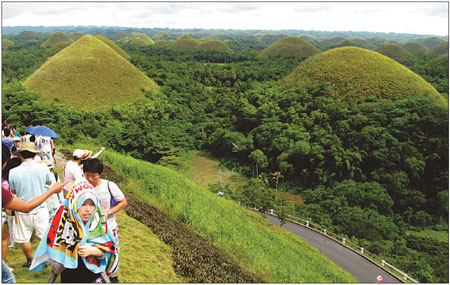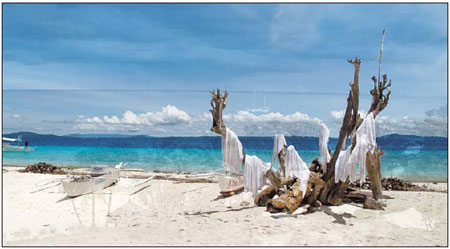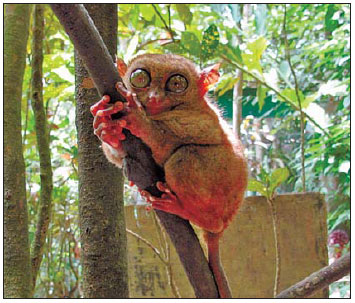Share Your Experience
Chocolate Hills and Fish Fairies
Updated: 2010-12-12 08:53
By Raymond Zhou (China Daily)
|
The Chocolate Hills on Bohol Island have given rise to many legends, none of which has anything to do with chocolate. Photos by Raymond Zhou / China Daily |
|
The white sand beach on Pamilacan Island |
|
Delicacies from the sea |
|
Tiny tarsier with ET eyes |
Away from the urban frenzy of its city centers, the Philippines can enchant visitors with countryside attractions that work like charms. Raymond Zhou escapes to Bohol and Cebu.
My trip to the Philippines was not sponsored by Hershey's, but it might as well have been, especially when I climbed 214 steps up the deck and was greeted by giant mounds of chocolate kisses ?except that these are giant hills scattered over an area of 50 square km.
There are 1,776 chocolate hills on the island of Bohol. Conical and symmetrical, they vary in size from about 30 to 50 meters in height to 120m for the tallest. Of course there is a scientific explanation for their formation, but who would want that when there is a much more charming explanation?
There are two versions, too - a rather hawkish version, and a more romantic one.
Once upon a time, two feuding giants were throwing boulders at each other until they were totally exhausted. They also forgot to clean up after the fight, and so the plains were littered with their mess, which, in the giants' scheme of things, is equal to human domes.
The romantic legend also features a giant, named Arogo. He falls in love with a mere mortal called Aloya. She grows old and dies while he remained eternally young, leaving him so grief-stricken that giant tears rolled off his cheeks and solidified into grassy knolls.
There are other tales of origin that involve a more basic bodily function, something not usually associated with beauty.
If the Chocolate Hills turn you into a sweet-toothed child, a cruise along the Loboc River will bring out the singing and dancing romantic.
Sipping from a fresh coconut and sampling local delicacies, your eyes and ears take in the lush forest and are surprised by the splashes the boys make when they swing off tree branches into the river. Singers on the cruise ship are very versatile and their rendition of the Chinese pop classic The Moon Represents My Heart is authentic enough to turn the solo into a chorus.
As you cruise along, the ship also stops at a hamlet where the villagers will invite the visitors to join them in the bamboo pole dance. But my most memorable moment was when we docked, and up on the roofed walkway, seven elderly gentlemen played zither in unison. It was mesmerizing.
Unless you want to join the boys for a dip, you don't have much chance to get wet during the cruise. For that you'll have to go to Pamilacan Island, an hour from the main Bohol Island. It is a paradise for snorkeling. At my guide's suggestion, I took some crumbs with me and tossed it into the water like the Chinese fairy scattering flower petals. Out of nowhere swarms of colorful fish started to swirl around my feet. I thought one would need special training to grow that kind of appeal - even in the marine world.
Dolphins are more elusive. We got up in the early morning and, even then, only caught a glimpse of the marine mammals frolicking at a place near Pamilacan. But it was my first time riding a Panga boat and the weather was perfect with sunshine gently caressing the vessel. I would have burst into Oh, What a Beautiful Morning if I had the vocal dexterity of a Filipino cover singer.
Bohol is home to the Philippine tarsier, a monkey-like primate so small it takes a trained eye to spot it in the woods. Measuring just 10-15 cm in body length, it has a 20-25cm long tail and a pair of big eyes reminiscent of E.T., the title alien in Steven Spielberg's sci-fi classic.

Tarsiers cannot survive captivity, but Bohol has achieved some success in developing a semi-wild enclosure for this endangered species.
To take photos of the tiny tarsiers, you have to disable your flash because it can damage the nocturnal creature's eyesight. And, you need to use a micro setting for your camera or you'll get nothing but a blur.
Apart from being a treasure trove for natural history, Bohol is also the place where the first international treaty of peace and unity was signed when in 1565. The native king Datu Sikatuna signed a "blood compact" with Spanish conquistador Miguel Lopez de Legazpi - an act celebrated in statues, movies and an annual festival.
But it is Cebu that offers history in abundance.
About two hours away by boat from Bohol, Cebu has the country's second largest city and an array of religious architecture. Here you'll see the oldest Christian image in the whole country, the Holy Child Jesus of Cebu, enshrined and venerated at the Basilica of Santo Nino.
Historical records show that this was a gift from Portuguese explorer Ferdinand Magellan to the wife of the Rajah of Cebu.
But it was also in Cebu that Magellan died. He had successfully befriended the king of Cebu and even baptized 700 islanders. But the ruler of nearby Mactan Island, Lapu-Lapu, was a rival battling with Cebu for control of trade.
The Battle of Mactan ended with the Spaniards defeated and Magellan killed, his body never recovered.
Today most international visitors come more for Cebu's sandy beaches and mouth-watering seafood. The seafarers of yore were possibly immune to the pristine beauty of the archipelago after spending so much time at sea. It takes a modern man, mired in the endless monotony of urban life, to appreciate the luxury of being able to sit underneath a coconut tree and gaze into the sunset.
E-paper

Ear We Go
China and the world set to embrace the merciful, peaceful year of rabbit
Preview of the coming issue
Carrefour finds the going tough in China
Maid to Order
Specials

Mysteries written in blood
Historical records and Caucasian features of locals suggest link with Roman Empire.

Winning Charm
Coastal Yantai banks on little things that matter to grow

New rules to hit property market
The State Council launched a new round of measures to rein in property prices.




